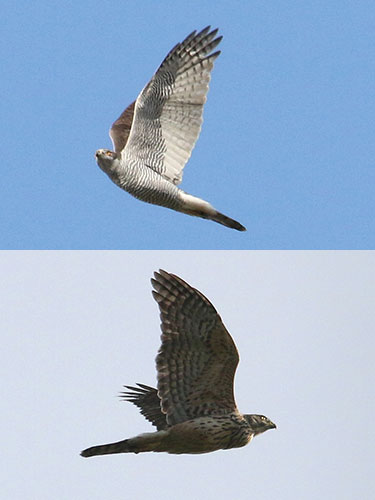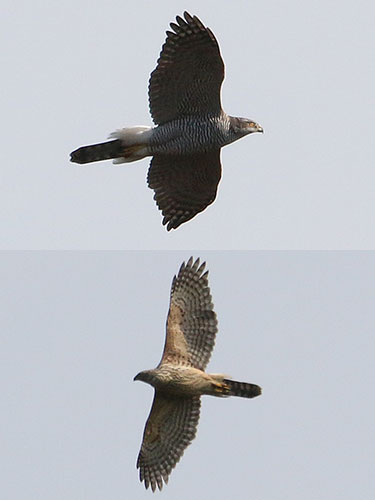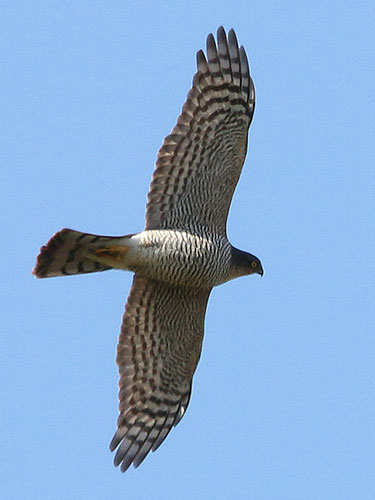


Adult male Goshawk (above) and first year male (below)
Photo: Mark Mallalieu

Adult female Goshawk (above) and first year female (below)
Photo: Mark Mallalieu

Female Sparrowhawk (for comparison)
Photo: Mark Mallalieu
Goshawks disappeared from the UK in the 19th century as a result of persecution, but populations are now well-established in many areas, probably derived from released and escaped falconers’ birds. In Sussex, at least one pair bred in 1993 and since then numbers have slowly increased so that now there may be 15-20 pairs across the county.
Goshawks can be difficult to separate from Sparrowhawks Accipiter nisus. Both species are sexually dimorphic. Female Goshawks are much larger than female Sparrowhawks; although slightly smaller than Common Buzzards, female Goshawks seen on their own can look huge and are often described as being the size of buzzards. Male Goshawks are smaller than females, about the size of a Carrion Crow and look bigger than female Sparrowhawks. Goshawks are always much heavier-looking than Sparrowhawks and in flight their wing-flaps are usually deeper and slower than those of Sparrowhawks, which typically flap their shorter-looking wings much faster. Goshawks have more protruding heads than Sparrowhawks and the end of the tail lacks the “sharp” corners shown by Sparrowhawks. Adult male and female Goshawks are white below with fine grey barring, but from a distance this can look white. Adult females look brown above and the males grey. Young birds under a year old are brown below with dark streaks and brown above, but structurally are similar to adults. The most recent field guides describe and illustrate these and other differences between the two species very well. However, be prepared to leave some birds unidentified, especially if seen at long distance.
Although often considered hard to see, Goshawks are in fact easy to detect where there are present. The territorial display consists of deep, exaggerated wing-flaps and “switchbacks” where birds accelerate, dive steeply, then shoot upwards, often repeatedly. The long white undertail-coverts are fluffed out and very conspicuous. This display is frequent in February - March, but can be seen from September to April in fine weather. When the young birds gain confidence from July - August, they are frequently seen sparring together above the woodland where they fledged. Goshawks can also be easy to see when they are hunting. They stooge around over woodland and farmland and then stoop onto Woodpigeons, a favourite prey. Indeed, flocks of panicking Woodpigeons are often the first sign that a Goshawk is nearby.
Although young Goshawks recently out of the nest may be mobbed by crows, older Goshawks are rarely mobbed in the way buzzards are, perhaps not surprisingly as female Goshawks are capable of killing birds much larger than crows.
Goshawks are still a “description species” in Sussex, so if you find one please send a description and ideally photos to recorder@sos.org.uk. Do go and search for them by finding a viewpoint overlooking large tracts of mature mixed or coniferous woodland in the High and Low Wealds, choosing a bright day with some wind. If you find a pair, please note whether they are adults or young birds. Goshawks can breed when they are less than a year old, but may not be as successful as older birds. Goshawks are probably still persecuted in some areas and at present the Sussex Ornithological Society www.sos.org.uk does not publicise breeding areas, though this may change in the future.
Every month it is our aim to highlight a species that is “in-season” and, although not necessarily rare or difficult to identify, has been highlighted by our local recording groups as being somewhat under-recorded and for which new records would therefore be welcomed.
If you or your recording group are aware of species such as this then please contact Bob Foreman.